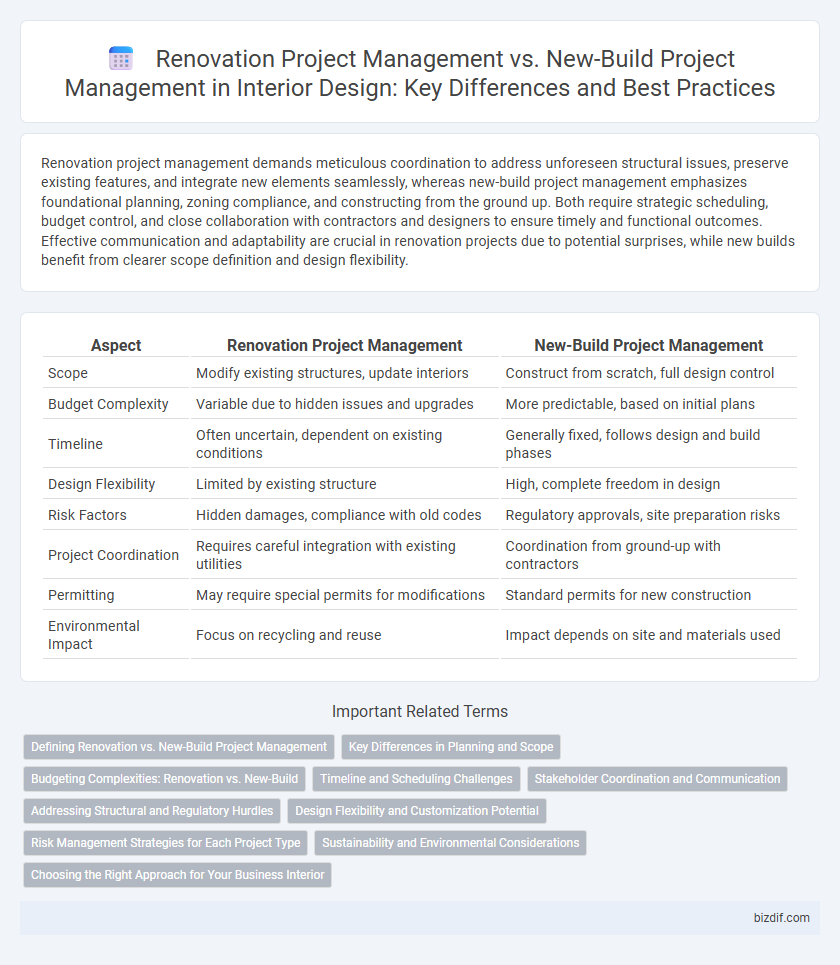Renovation project management demands meticulous coordination to address unforeseen structural issues, preserve existing features, and integrate new elements seamlessly, whereas new-build project management emphasizes foundational planning, zoning compliance, and constructing from the ground up. Both require strategic scheduling, budget control, and close collaboration with contractors and designers to ensure timely and functional outcomes. Effective communication and adaptability are crucial in renovation projects due to potential surprises, while new builds benefit from clearer scope definition and design flexibility.
Table of Comparison
| Aspect | Renovation Project Management | New-Build Project Management |
|---|---|---|
| Scope | Modify existing structures, update interiors | Construct from scratch, full design control |
| Budget Complexity | Variable due to hidden issues and upgrades | More predictable, based on initial plans |
| Timeline | Often uncertain, dependent on existing conditions | Generally fixed, follows design and build phases |
| Design Flexibility | Limited by existing structure | High, complete freedom in design |
| Risk Factors | Hidden damages, compliance with old codes | Regulatory approvals, site preparation risks |
| Project Coordination | Requires careful integration with existing utilities | Coordination from ground-up with contractors |
| Permitting | May require special permits for modifications | Standard permits for new construction |
| Environmental Impact | Focus on recycling and reuse | Impact depends on site and materials used |
Defining Renovation vs. New-Build Project Management
Renovation project management involves overseeing the update or improvement of existing structures, requiring detailed assessment of current conditions and integration with existing design elements. New-build project management focuses on constructing structures from the ground up, emphasizing foundational planning, site development, and adherence to architectural blueprints. Both approaches demand distinct strategies tailored to scope, timelines, and resource allocation in interior design projects.
Key Differences in Planning and Scope
Renovation project management involves navigating existing structures, requiring detailed assessment of current conditions and adaptability to unforeseen challenges, whereas new-build project management allows for a clean slate with more predictable planning and scope definition. Scope in renovation projects often includes preserving historical elements and integrating modern updates, while new-builds emphasize foundational design and full customization. Planning timelines for renovations typically face more variability due to discovery phases, unlike new builds which follow a more linear schedule from ground-breaking to completion.
Budgeting Complexities: Renovation vs. New-Build
Renovation project management involves unpredictable budgeting complexities due to hidden damages and the need to integrate existing structures, often leading to cost overruns and contingency funds. New-build project management benefits from more accurate initial budgeting based on detailed plans and standardized materials, reducing financial uncertainties. Understanding these differences is crucial for precise financial planning and resource allocation in interior design projects.
Timeline and Scheduling Challenges
Renovation project management requires navigating unpredictable delays due to existing structural issues, making timelines more fluid compared to new-build projects which follow more linear schedules with defined phases. Scheduling challenges in renovations often involve coordinating trades around live environments and unexpected discoveries, whereas new-build projects allow for more precise sequencing of tasks. Effective time management in renovations demands flexibility and contingency planning to mitigate disruptions and maintain progress.
Stakeholder Coordination and Communication
Renovation project management demands intricate stakeholder coordination due to existing structural constraints and the need to accommodate the occupants' schedules, requiring precise communication strategies to minimize disruptions. New-build project management allows for more streamlined communication by engaging stakeholders early in the design phase, aligning expectations, and facilitating seamless collaboration among architects, contractors, and clients. Effective stakeholder coordination in both contexts hinges on regular updates, transparent information flow, and proactive conflict resolution to ensure project timelines and budgets are met.
Addressing Structural and Regulatory Hurdles
Renovation project management involves navigating existing structural limitations and ensuring compliance with updated building codes and zoning regulations, often requiring detailed assessments and permits before construction begins. New-build project management allows for more flexibility in design but demands strict adherence to initial regulatory approvals and construction standards from the outset. Addressing these structural and regulatory hurdles effectively minimizes project delays and cost overruns in both renovation and new construction scenarios.
Design Flexibility and Customization Potential
Renovation project management in interior design demands high adaptability due to existing structural constraints, limiting design flexibility compared to new-build projects where customization potential is maximized from the ground up. New-build project management allows designers to tailor layouts, materials, and systems without legacy limitations, enabling comprehensive personalization aligned with client vision. Effective renovation management requires innovative solutions to integrate modern design elements while navigating pre-existing conditions, offering a balance between preservation and contemporary customization.
Risk Management Strategies for Each Project Type
Renovation project management prioritizes risk management strategies addressing unforeseen structural issues, budget overruns, and tenant disruption, employing thorough site assessments and contingency budgeting. New-build project management emphasizes risk mitigation through detailed planning, regulatory compliance, and supply chain coordination to prevent delays and cost inflation. Both project types implement continuous monitoring and stakeholder communication to adapt risk responses effectively.
Sustainability and Environmental Considerations
Renovation project management in interior design prioritizes sustainability by utilizing existing structures and materials, reducing waste and minimizing environmental impact compared to new-build projects. New-build project management demands comprehensive planning to incorporate energy-efficient systems, sustainable materials, and green technologies from the ground up. Both approaches require stringent adherence to environmental regulations and certifications such as LEED or BREEAM to ensure eco-friendly outcomes.
Choosing the Right Approach for Your Business Interior
Renovation project management in interior design often involves coordinating with existing structures, managing unforeseen challenges, and maximizing current space efficiency, ideal for businesses aiming to preserve brand identity while upgrading functionality. New-build project management requires comprehensive planning from the ground up, allowing complete creative freedom and integration of modern systems, best suited for businesses seeking a customized, scalable environment. Selecting the right approach depends on factors such as budget, timeline, business goals, and the physical condition of the existing space.
Renovation project management vs New-build project management Infographic

 bizdif.com
bizdif.com